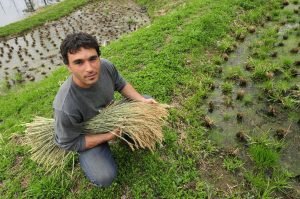

Photo source: https://greentriangle.org/2015/10/19/green-triangle-hosts-ben-falk-author-of-resilient-farm-and-homestead-this-week/
by Jeb Wallace-Brodeur.
Excerpt from The Resilient Farm and Homestead by Ben Falk
"In difficult dry regions of the Iberian Peninsula, a complex agroforestry system based heavily on the interactions between an oak-and-chestnut overstory and a grazed understory (using pigs and small cows especially), called the dehesa system, was devised, likely in the first millennium AD. Grazing animals were rotated through the woodlands, with animals thriving primarily on the produce of the trees. The nuts offered a wellspring of fat and protein from year to year, with no pruning, no fertilizing (other than animal rotations), little disease pressure, no irrigation, no bare soil, no erosion, and complete groundwater recharging/moisture retention. This kind of land use is the opposite of desertification. The productivity of the dehesa system has been found to be higher per unit area than any version of modern agriculture in Spain, when accounting for all inputs and outputs. At the same time the quality of the systems’ outputs is superior to those of modern agriculture: Chestnut-fed swine has long been regarded as one of the finest meats in the world, as flavorful as it is dense in nutrients, beyond comparison with grain-fed meats. The savanna-mimicking dehesa silvo-pastoral systems were so widespread, evolved, and practiced for so many centuries that until the twentieth century many ecologists did not recognize the anthropogenic origins of these ecosystems. As the agroforestry practices of planting, cutting, pruning, and grazing waned in the modern era, so, too, has the diversity of “wild” life in these woodlands. While springs dried up, soil building slowed, and the region has become more arid and brittle and less productive. It is probable that, as in many abandoned or untended places, diversity dropped when beneficial human management was removed: Lack of good grazing removed fertility from the cycle—while poor grazing eroded land, and trees stopped being replanted.”
The Resilient Farm and Homestead: An Innovative Permaculture and Whole Systems Design Approach - 2013
Chapter 2: THE DESIGN PROCESS AND SITE ESTABLISHMENT
Subsection: Schematic Design: Sorting Through Multiple Development Options
Posted from my blog with SteemPress : http://www.agsurrection.com/2018/03/12/master-quote-ben-falk-03-12-18/
Hi! I am a robot. I just upvoted you! I found similar content that readers might be interested in:
https://www.scribd.com/document/143074902/Chapter-1-Creating-a-Positive-Legacy-while-Adapting-to-Rapid-Change
Very nice post
Interesante Post. la alimentación de estos animales, muy nutritiva para ese momento. En venezuela en la actualidad a los cerdos se le alimenta con el desperdicio del maíz, (nepe) , también auyama (calabaza). en cuanto a las cabras o chivos, se pastorean en lugares con mucha hierba, para que se alime.nten